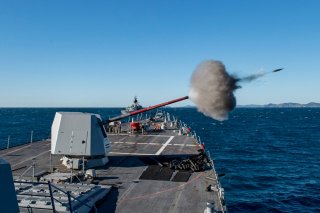Chinese Navy Says It Can Intervene to Stop U.S. Defense of Taiwan
Last week, the Chinese People’s Liberation Army Navy (PLAN) conducted multi-domain air attack drills from two aircraft carriers in the Western Pacific.
Last week, the Chinese People’s Liberation Army Navy (PLAN) conducted multi-domain air attack drills from two aircraft carriers in the Western Pacific. Chinese J-15 fighter jets as well as Z-9 and Z-18 helicopters practiced takeoffs and landings from the Liaoning aircraft carrier strike group as part of an effort to project power into the South China Sea and demonstrate China’s ability to annex Taiwan.
The Chinese government-backed Global Times newspaper specifically cites the PLAN’s forward carrier presence as a capability that could be used to deter and defeat U.S. and Japanese forces defending Taiwan.
“Chinese military observers said West Pacific [sic] is also an important potential battlefield if foreign forces like the US and Japan interfere in the Taiwan question, as Chinese aircraft carriers could take positions here and fend off foreign forces, while also surrounding the island of Taiwan from its east,” the paper states.
Could Chinese carriers in the Taiwan Strait or in striking distance of Japan successfully defend Taiwan from U.S. and Japanese attack? Chinese carriers and amphibious warships might be quite successful in any amphibious assault to take over Taiwan, especially if U.S. and Japanese forces could not get there in time or were prevented from coming to Taiwan’s aid by China’s formidable arsenal of missiles and other anti-access/aerial denial assets.
However, should Japanese, South Korean, or U.S. military forces or intelligence services receive sufficient indication of an imminent invasion, U.S. Navy and Japan Maritime Self-Defense Force assets pose a preemptive challenge and stop a Chinese takeover of Taiwan. This is likely a key reason why U.S. Indo-Pacific Command operates a large number of ships and assets in the Indo-Pacific region and regularly conducts forward operations such as training, combat preparation drills, and carrier aircraft launch operations. Forward presence could be the deciding factor in any kind of scenario involving an attack on Taiwan.
Despite the claim stated by the Global Times that PLAN carriers could prevent a successful U.S. and Japanese intervention on behalf of Taiwan, there are several key reasons why PLA forces might have trouble actually succeeding in taking the island. First, attacking Chinese forces would likely have a very difficult time establishing air superiority in support of an amphibious assault. Should U.S. aircraft carrier-launched F-35C Joint Strike Fighters and amphibious-launched F-35Bs jets be within the range of attack, Chinese J-15s or even some of its small number of J-20s would likely have trouble. Without establishing air supremacy, a Chinese amphibious force would be extremely vulnerable to attack from U.S. or Japanese fifth-generation aircraft such as F-35s.
Another key variable likely to make a Chinese move on Taiwan very difficult is the potential presence of U.S. submarines. Virginia-class attack submarines are increasingly engineered with advanced sonar and quieting technologies such that they can stealthily approach high-risk areas that would be off-limits to more easily detected surface ships. Hidden U.S. Navy attack submarines can perform clandestine reconnaissance missions in high-risk coastal areas and, should they remain undetected, could succeed in attacking, disrupting, or even destroying attacking Chinese ships en route to Taiwan.
Kris Osborn is the defense editor for the National Interest. Osborn previously served at the Pentagon as a Highly Qualified Expert with the Office of the Assistant Secretary of the Army—Acquisition, Logistics & Technology. Osborn has also worked as an anchor and on-air military specialist at national TV networks. He has appeared as a guest military expert on Fox News, MSNBC, The Military Channel, and The History Channel. He also has a master’s degree in Comparative Literature from Columbia University.
Image: Flickr.

